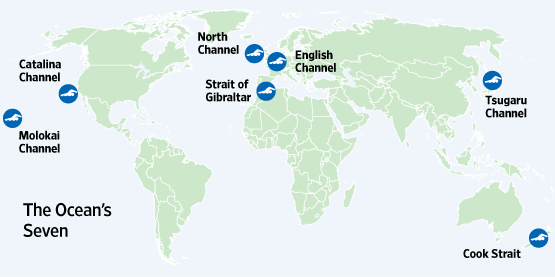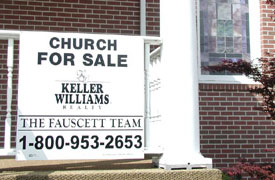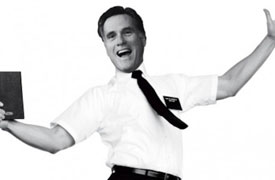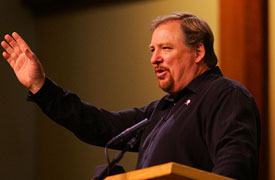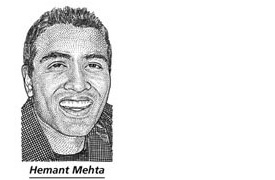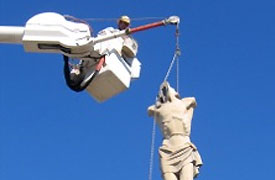True Believers
Health Claims by Sales Force Boost Supplement Firm
By Suzanne Sataline
May 11, 2007

When doctors found a tumor in Angie McHenry’s bowel in the spring of 2006, they told her that her cervical cancer had become terminal. But her uncle, Stephan Huffman, gave her some hope.
Mr. Huffman, a retired high-school teacher, is a sales associate for Mannatech Inc., a publicly traded company that markets vitamins and nutritional supplements. He and his wife persuaded Ms. McHenry to swallow, each day, 32 Mannatech tablets and six scoopfuls of the company’s Ambrotose, a derivative of aloe vera and larch-tree bark.
“He said it would knock the cancer away,” recalled Ms. McHenry, a Coldwater, Ohio, mother of three, in an interview last month. “I would go into full remission. He said he had seen proof in other people.”
Mannatech, based in Coppell, Texas, relies on an army of enthusiastic consumers of its nutritional supplements to sell the products to family, friends and others. These sellers are unsalaried, but receive commissions and bonuses from the company, based in part on their recruitment of other sellers. Some of them make sweeping claims about the power of Mannatech products to provide relief from serious diseases.
In the eight years since Mannatech went public, several questions have loomed large for company executives and board members: Are nonemployee salespeople pushing its products in ways that violate Food and Drug Administration guidelines? And how far should Mannatech go in policing its free-lance sales force?
About half of Mannatech’s supplements, the company says, contain nutritional sugars it calls “glyconutrients.” The body needs simple sugars, but some scientists say there is no proof that sugar supplements provide health benefits. Mannatech say its glyconutrient mixture, called Ambrotose, “supports the immune system.” Because none of the products are approved by the FDA for the treatment of disease, it isn’t legal for anyone to market them as such.
Mr. Huffman, who sold $1,200 of Mannatech products to Ms. McHenry, says he doesn’t recall telling her they would “knock her cancer away.” He adds, though, that “in many instances,” Ambrotose “encapsulates the cancer.”
Ms. McHenry consumed the tablets and powder for two weeks last year, she said, until nausea made them difficult to swallow and her oncologist persuaded her to quit. Mr. Huffman says he returned her $1,200 to alleviate hard feelings. Ms. McHenry died on April 20.
“Nobody is claiming these products by themselves are providing a treatment for disease,” says Mannatech Chairman and Chief Executive Sam Caster, one of the company’s founders.
Mr. Caster identifies himself as a Christian, and some customers are drawn to the company for that reason. He and his wife, Linda, refer to Mannatech as a blessing, and say God spoke through her to give him the idea for the company. Many top salespeople share their religious beliefs. Marshall Howard, a salesman who says he’s a Christian, recently told hundreds of associates at a gathering that they were “chosen” people in the “glorious mission of Mannatech to change hundreds of thousands of lives.”
Such fervor is visible when Mannatech devotees, many of them nonsalaried sales associates, gather for an annual company-sponsored event called MannaFest. At this year’s gathering, a four-day affair held in Dallas in March, at least 10 people came on stage one night to testify that after taking Mannatech products, they recovered or found relief from conditions ranging from paralysis to tumors to lesions. Another 25 people said they took glyconutrients and found relief from afflictions such as leukemia, arthritis, cystic fibrosis, Down syndrome and cancer.
Mr. Caster says the consumer testimonials are perfectly legal because none use the words “cure,” “treat” or “mitigate” in referring to diseases. Mannatech product labels, which are reviewed by the FDA, state that the products are “not intended to diagnose, treat, cure or prevent any disease.”
Mr. Caster says that message is repeated frequently during conference calls with associates. He says he and the company abide by all laws, and train associates to do the same.
Nevertheless, scrutiny of the company’s marketing has been increasing. The Federal Trade Commission has logged at least 30 complaints about Mannatech since 1998 alleging deception, making false health claims, and improper sales practices. The FTC has brought no action.
After reports about the company’s sales tactics caused its stock to drop in 2005, shareholders filed lawsuits in state and federal courts. Several have been consolidated as a federal class-action in Dallas federal court. It alleges that executives knew about and ignored improper health claims by employees and salespeople, and that Mr. Caster overruled recommendations by the company’s regulatory-compliance committee to discipline big sellers who made such claims.
Mr. Caster says the company has fined some associates as much as $25,000, and has terminated some for making improper claims. “Does something like this ever get away from us?” he says. “Well, of course. Those are the types of things that we’re out there looking for, and that we’ll catch.” He says the company intends to vigorously defend itself in the litigation.
The Texas attorney general’s office indicated in a memo last October that it had been investigating Mannatech for possible health-law violations since 2005. The memo, reviewed by The Wall Street Journal, said the state “anticipated filing suit against” Mannatech for alleged violations, including “unproven health claims.” To date, the attorney general has taken no action. A spokesman for the attorney general declined to comment.
Mannatech’s vitamins, powders and capsules aren’t sold in any stores. The company sells them over the Internet, and through a large sales force of free-lancers. It has no salaried sales force. Companies whose salespeople are independent, and are paid based on their own sales and those of other sellers they directly and indirectly recruit, are known as “multilevel marketers.”
Mannatech has more than 100,000 active sales associates, arrayed in a hierarchy. Mannatech pays commissions to associates based on the purchases of the associates they recruit and others down the line from them. To be eligible for financial bonuses, an associate must buy $100 in Mannatech products each month. Top Mannatech associates have earned as much as $1.6 million a year, according to compensation information shared with associates at MannaFest.
Books, home and beauty products, and cleaning materials have long been peddled in this fashion. These days, so are many nutritional supplements. Multilevel marketers accounted for $4.4 billion of $22 billion in sales of dietary supplements in 2006, says Grant Ferrier, editor of Nutrition Business Journal.
Mr. Caster helped start Mannatech in 1993. Months later, Congress passed the Dietary Supplement Health and Education Act. Under that law, makers of dietary supplements aren’t currently required to document that their products are safe or effective. But it bars them from claiming, without FDA approval, that any product can treat, cure or prevent illness.
Mannatech went public in 1999, and sales have grown steadily. Last year, Mannatech earned $32.4 million on sales of $410 million, compared with $1.9 million earned in 2002, on sales of $141 million.
Early on, Mr. Caster and his wife turned to friends and prayer partners to sell products and recruit other salespeople, according to Ms. Caster’s self-published book, “Undeniable Destiny.” Steven Barker, a professor of veterinary medicine at Louisiana State University who served as a Mannatech director from 1998 to 2002, said the board was concerned about religious influence on marketing.
“People would become overzealous and start making claims that this was manna and it had miraculous properties, that it was God’s gift,” says Mr. Barker. “Sam is a very religious individual, and he would listen to people making claims they thought were miraculous….The board wanted him to tone it down. They didn’t want it to become a revival, some kind of ultrareligious event.”
Roger E. Beutner, a retired engineer who served on the board until 2003, says “exaggerated” claims about product benefits made some directors uncomfortable.
Co-founder Charles “Skip” Fioretti, then chairman and chief executive of Mannatech, worried that the FDA could take action on unproven claims, says Mr. Barker. In addition, there was tension between Messrs. Caster and Fioretti over business issues. In 2000, the board removed Mr. Caster as president after what he says was a clash of values with Mr. Fioretti. Mr.
Caster became co-chairman, but quit weeks later. Mr. Fioretti did not return calls seeking comment.
Mr. Caster’s supporters were upset, according to Mr. Barker, and Mr. Caster returned as a director within weeks. Mr. Caster says he made it clear that he and his wife intended to talk about their faith when speaking about the company. Eventually, more of his supporters joined the board, and by 2002, Mr. Fioretti had left. Mr. Caster became chairman, and later, chief executive.
These days, God and the Bible are mentioned frequently by some sales associates during meetings and conference calls. At this year’s MannaFest, one associate led a training workshop called “Leadership Lessons from Moses,” which used quotes from Exodus. At “Leadership Skills from a Biblical Perspective,” associate Dottie Anderson described “Jesus as the first network marketer.”
To sell the products, many associates rely on testimonials and case histories. At Mannatech conferences, H. Reginald McDaniel, a Dallas-area pathologist and the company’s former medical director, sells various reports containing case histories. He says he has chronicled hundreds of cases of patients with cancer, Parkinson’s disease, allergies, and cystic fibrosis whose health improved, and some whose symptoms disappeared, after taking glyconutrients. “I’d be derelict if I implied everyone with an improved diet gets a turnaround in health, yet a significant number do,” he says.
During the “testimonials” program at this year’s MannaFest, a mother showed slides of her two sons in hospital beds. After taking glyconutrients, she said, they are now free of brain seizures. A young man walked to the microphone and told the crowd that he had been paralyzed from a car crash before taking Ambrotose.
Jordan Scott, a wan 13-year-old from Lubbock, Texas, said that when she was a toddler, cystic fibrosis frequently left her choking on mucus and battling lung infections. She began taking glyconutrients, she said, and she can now play the oboe, and she placed third at a cross-country meet. “A doctor said I have the lungs of a healthy child,” she said, sobbing and thanking God, as the audience applauded.
Mr. Caster says Mannatech products are “not a cure for cystic fibrosis….I think dietary supplements can improve the quality of life.”
“I have never, ever said” that testimonials “should substitute for science,” Mr. Caster says. Health benefits reported by users, he says, help “guide us in our research.” Mannatech says it is conducting studies on the benefits of using its products.
Some researchers says they doubt that Ambrotose offers any health benefits. Hudson Freeze, who studies complex carbohydrates as a professor of glycobiology at the Burnham Institute for Medical Research in La Jolla, Calif., contends the body can’t digest Ambrotose because humans lack the enzymes necessary to break down the plant fibers it contains into simple sugars.
Mannatech has said it has completed a study that shows the body can break down glyconutrients, and that it is slated for publication in the Journal of Alternative and Complementary Medicine. The journal’s managing editor, Barbara Nell Perrin, says it will publish an abstract of the study that will not be peer-reviewed.
Mannatech associates often post messages on Web sites, including the MannaShare forum on Yahoo.com, seeking tips on selling Mannatech products to people with specific afflictions, including cocaine addiction, hemophilia and Down syndrome.
“If anyone anywhere has any information — studies, testimonies, anything — on glyconutrients and esophageal cancer — PLEASE e-mail it to me,” Mannatech associate Joan Francis, of Batavia, N.Y., wrote in January on one forum, after her father had been diagnosed with the disease.
After posting the message, Ms. Francis says, she consulted with several doctors who recommended amounts of Mannatech glyconutrients to take. Dr. McDaniel, the company’s former medical director, was one of them, she says. Ultimately, she persuaded her father to forgo chemotherapy and take Mannatech supplements.
Her father, George Schaefer Jr., says he was skeptical, but agreed to try. He bought about $700 worth of supplements over two months. Recently, on the advice of his son, he stopped taking the products and switched to chemotherapy, Ms. Francis says.
Betty Wiggins, a Durand, Mich., grandmother who identifies herself as a nurse, says she has advised more than 3,000 people over the past five years to take Ambrotose for everything from vomiting to cancer. For lung
cancer, for example, she says she recommends 100 grams of Ambrotose per day. “I don’t have anyone who hasn’t fully recovered from any illness,” she says. “You aren’t supposed to say someone is healed, for some reason.”
The Texas Department of Health Services periodically reviews Mannatech’s product labels and promotional materials, among other things. Cynthia Culmo, a former director who oversaw Mannatech inspections, says that recommending Ambrotose to treat a disease, or specifying dosage amounts beyond the guidance given on the label, are “likely” violations of federal law.
Mr. Caster says he did not know about Web sites that suggest dosage amounts.
For the desperately ill, the Web sites can be seductive. Jackie Wells, a nurse in New Mexico, was diagnosed last year with amyotrophic lateral sclerosis, the degenerative nerve disease that killed Lou Gehrig. A Web site suggested treatment with glyconutrients, and she consumed $130 of Ambrotose over six months. She has lost use of her arms and now relies on her husband to feed her and brush her hair. “I felt like somebody had taken advantage of me,” she says.
After Jeffrey Cook of Sleepy Eye, Minn., was diagnosed with renal cell carcinoma, two local Mannatech associates gave him a DVD containing testimonials, recalls his wife, Jane. “The video showed a guy with the same type of cancer,” says Ms. Cook, a licensed nurse. “It had healed him, basically.”
The associates, Melissa and Pat Schroepfer, sold Mr. Cook $1,000 worth of glyconutrient products, says Ms. Cook. Mr. Cook died last October, a month later. The Schroepfers reimbursed her the money. Melissa Schroepfer declined to comment, and Pat Schroepfer, her father, didn’t return calls.
![]()
